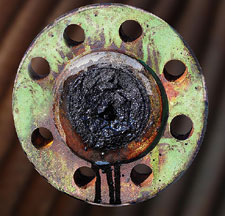 Technology from Europe: Technology from Europe:
France, Germany
Monitoring field pipewall deposition with a new non-intrusive device
Françoise Brucy, IFP, Rueil-Malmaison, France, and Thierry Romanet, Cybernétix, Marseille, France
A new device for the detection of deposits that build up at the wall of pipelines and flowlines during production underwent recent industrial development by Cybernétix and IFP, in partnership with Total. It was further tested in early 2005 for 100 days on an onshore production line operated by Geopetrol, in southwest France.
The line produces Montastruc field. Well MTC4 has a diameter of 2 in., is about 500 m long and is buried at a depth of 1.80 m after the wellhead. It produces 12 m3 (75 bbl) per day of water-free oil. It is periodically pigged using a foamy pig.
 |
Wax deposit at spool end.
|
|
Two devices were installed on the pipeline, near the wellhead, for demonstration. One was placed downstream of the pig entry station and the chemical-injection point. The second one was placed upstream of the pig station on a spool piece of the pipeline, which was first dismantled, cleaned with a high-pressure water cleaner, and reassembled. The presence of a substantial waxy deposit was observed, estimated at 5 to 10 mm thick (see figure). The Wax Appearance Temperature of the produced oil is 28°C, while a deposit sample exhibited a WAT of 53°C.
The detectors were installed on the outer wall of the pipeline and were linked to the same acquisition system. The system for detecting deposits is based on a simple thermal principle: a defined quantity of heat is injected for a short time, using a heat source, while a sensor records the thermal responses. A 1-hour measurement cycle is imposed, including 5 min. of heating, with recordings every 2 sec., repeated every hour during the 100-day campaign. The measurement data acquired by both deposit detectors was processed in real time by a computerized method to give the deposit thicknesses. The method is derived from the modeling of heat transfers in the pipeline wall and fluid, in various conditions.
A daily measurement was recorded at 11 p.m. due to better external thermal stability at night, and then processed. The computerized deposit thicknesses obtained downstream of the pig entry station do not show any significant variations over 100 days, whereas those obtained upstream of the station indicate monotone growth. These observations are explained by the periodic scraping at the position of the downstream detector, which does not take place at the position of the upstream one.
In addition, after cleaning the pipeline section corresponding to the upstream detector on the 87th day, the computerized thickness returns to its initial level, while the downstream thickness does not vary. Cleaning made it possible to directly observe the presence of wax deposits, revealing the waxy build-up in this section, with an average 10-mm thickness, which is in agreement with the computer-derived thickness.
The field observations and quantifications of deposit detector data acquired during the Montastruc campaign demonstrate that it is possible to measure a deposit using non-intrusive instrumentation. Deployment of the deposit detector and associated technologies is now awaiting the first Track Record results, particularly in offshore conditions.
The deposit detection system is planned as a turnkey system, comprising a sensor-clamp package and the associated monitoring computer, running the acquisition software and the IFP thickness-calculation model. The company proposes the deposit detection system within a project scheme, including project management, detailed engineering, procurement, construction and all associated services, from site installation to commissioning, startup and maintenance. 
|

 Technology from Europe:
Technology from Europe:

